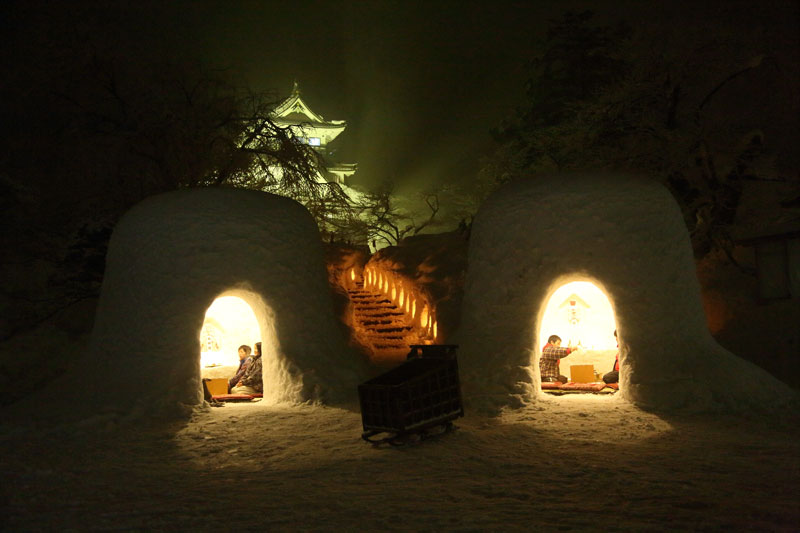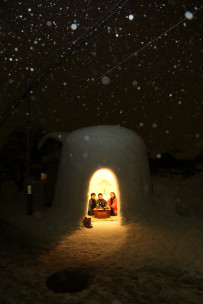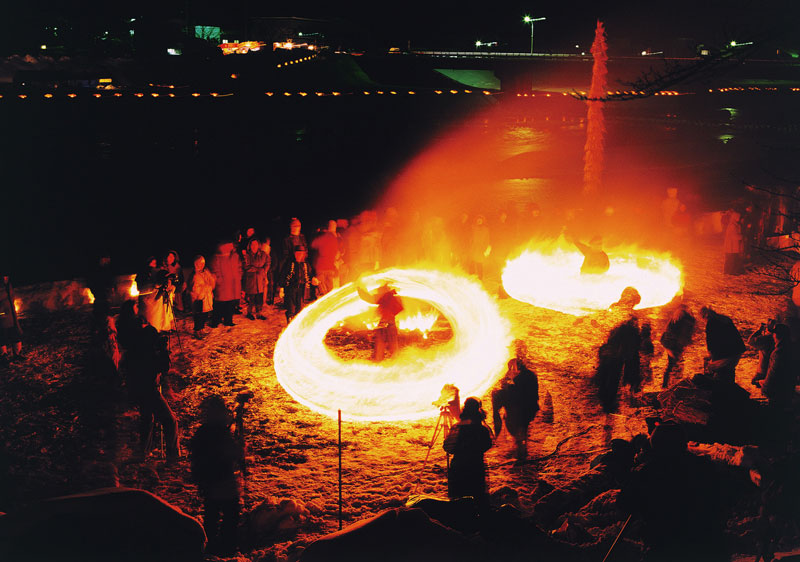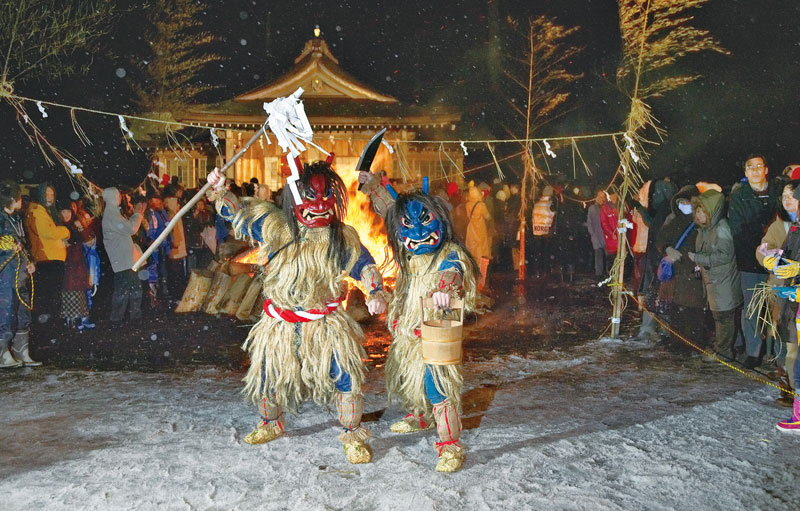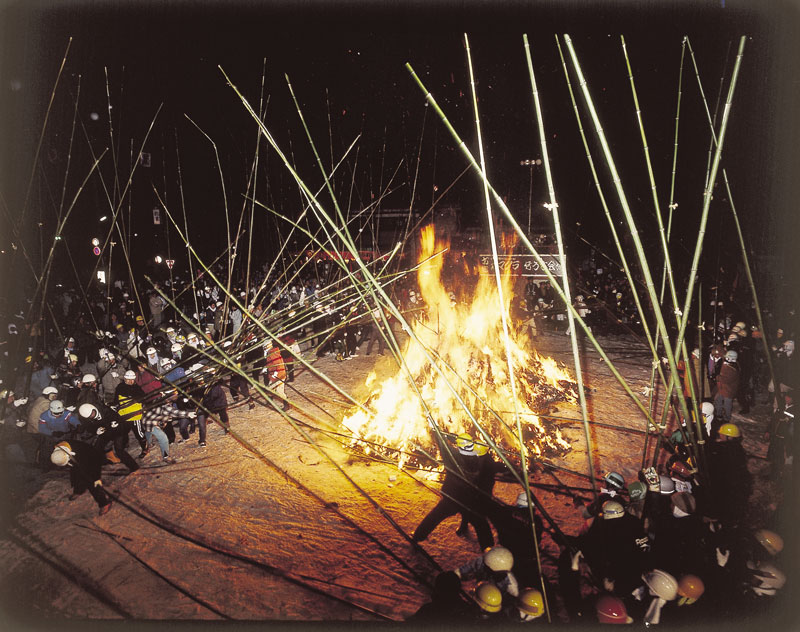As temperatures drop in Akita, coats of white begin to cover the many colors of this northern land, and unless you’re a winter sports enthusiast, you’re not likely to be spending more time outside than you have to.
Yet even during these frigid months, the people of Akita continue to take part in a variety of festivals that force revelers to brave the elements. In the past, these celebrations and rituals were held during the darkest and coldest time of winter, in the hopes of supporting healthy crops, as well as the health and safety of their families and communities. Now, whether they are observed by sharing food and drink in huts made of snow, or engaging in town-wide competitions, these celebrations of fire, ice, and folklore are a testament to the toughness of these northern people and their joy in keeping centuries-old traditions alive.
Kamakura Snow Festival
In southeastern Akita Prefecture lies the city of Yokote. The region is home to what can be brutally cold winters, but the people
of Yokote choose to embrace the low temperatures as they celebrate the town’s most well known festival. Following a tradition that has been maintained for 400 years, the people build what are known as kamakura—small, round houses that look like igloos—along the streets of the city’s central neighborhoods and leading up to the shadow of Yokote castle.
These huts, which stand up to 2 meters high, and 1.5 meters across, are lit from within—now mostly with electric lamps—and while you couldn’t say they were toasty inside, you can be sure of a warm welcome when you cross their thresholds. The people hosting these huts of snow are grilling mochi and heating up amazake, and you can expect to be beckoned into countless kamakura with a hearty agattetanse!—the Akita dialect version of irasshaimase.
Traditionally, the kamakura house a shrine dedicated to a Shinto water god, and the festival was held as a means of praying for good harvests, as well the success and safety of their communities—including protection from fire. But you don’t need to worry about following any special rituals: just eat, drink, and enjoy your hosts’ hospitality.
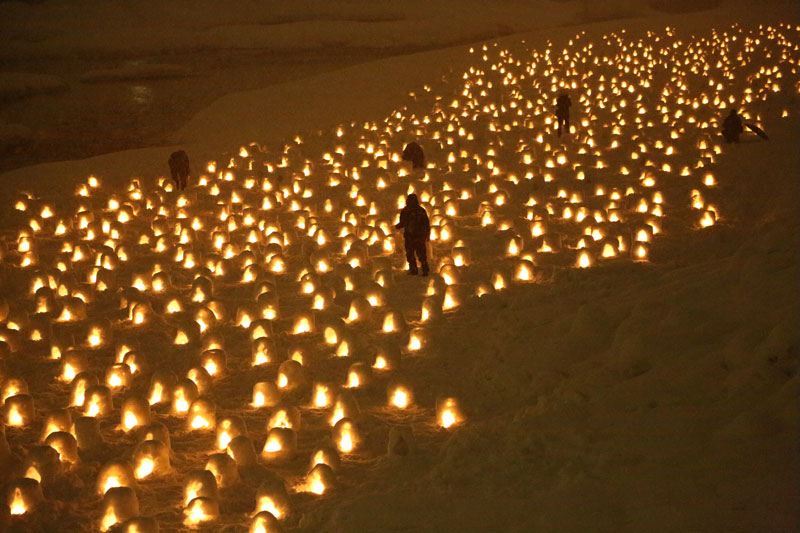
In addition to the full-size kamakura, the residents of Yokote create miniature versions, each glowing with its own small light
Hiburi Kamakura Festival
While Yokote’s festival has its origins in protection from fire, Kakunodate’s Hiburi Festival uses the very element itself as a purifying element.
Kakunodate lies not far to the north of Yokote, and is known for its black-walled samurai houses and its rich feudal history. Another of the city’s cultural legacies is one that goes back at least as far as these warriors of generations past.
Marking the opening of the new lunar year with a celebration as picturesque as it is primal, participants in the Hiburi Festival (the name itself means “fire swinging”) clear out the bad fortune of the year before with a show of light.
In the wide open spaces around the city, townspeople and visitors grab hold of lengths of straw rope, which are attached to bales of hay and lit by a ceremonial flame. Beginning the motion slowly, they swing the bales of flame over their heads and around their bodies. For the moments that pass until the flames start to creep up the rope, participant and fire are connected in a bright, purifying dance that lights the night sky.
Namahage—The Fierce Visitors from the Mountains
One of Akita’s best-known symbols is the fearsome mask of the namahage—huge, ogre-like figures that were believed to bring good luck to the villages they visited as they made their way down from the mountains. Of course, these were men from the villages, garbed in straw coats and wearing masks, and the gruff questions they would put to the villagers, particularly children—were meant to encourage good behavior and maintain harmony in the year to come.
While you can find namahage masks and statues throughout the length and breadth of the prefecture, the origin of this folkloric figure lies on the western coast of Akita, and the Oga Peninsula. A rocky, axe-shaped outcropping that protrudes into the Japan Sea, this region is known for its rugged, attractive coastlines, fresh and delicious seafood, and the namahage. The most impressive time to see namahage “in the flesh” is at the Namahage Sedo Festival in Oga City.
In preparation for the festival, which is held in the middle of February, several young men don the crimson masks, which have been blessed at a shrine. They make their way up nearby Mt. Shinzan, and as the festival begins, they descend from the mountain into the city, bearing torches and beating drums. After being placated with rice cakes (and scaring a few guests), the namahage return from whence they came.
Competitive Festivals
Japanese culture is known for its appreciation of group harmony and cooperation. Frequently, in order to get along, this means that it is necessary to swallow one’s pride and get along, but the tension builds up over time. Two festivals in Akita are perfect demonstrations of just how important it is to be able to blow off steam now and again, challenging your neighbors instead of always working together.
Held in the city of Daisen, the Kariwano Tug-of-War is a competition that is connected to Akita’s most important crop. The villagers divide into north and south and settle their differences with a giant rope made of rice straw. The main rope is made of rice straw and measures 70 cm (27 inches) in diameter, 65 meters long, and weighs ten tons. The hundreds of people who take part pull the rope itself using smaller lateral ropes, and fueled by a spir- it of competition—as well as a few cups of sake—the north and the south side of the town strive to win the struggle. It was believed that if the north side won, the rice crop would be particularly successful that year, while if the south side was victorious, the price of rice would go up.
Not far away, in Rokugo, Misato, the festival of Takeuchi takes the competition to an even more intense level. The stakes in this competition are the same as the tug-of-war—a win-win situation—but the competition is handled by teams of men carrying six-meter-long bamboo poles. The teams fight three rounds to see which group can drive the other across the field of play. For the final skirmish, poles are lit in a ceremonial fire. Finally, when the fiery battle in the snow comes to an end, hands are shaken, and communal ties are restored over laughter and sake.
More Information
The Kariwano Tug-of-War is held on February 10 in Daisen
The Hiburi Festival is held on February 13 and 14 in the city of Kakunodate
The Takeuchi Festival/Battle is waged on February 15, in Misato
The Kamakura Snow Festival takes place on February 15 and 16, in Yokote City
Akita’s official Facebook page:
www.facebook.com/discover.akita
Updated On December 26, 2022

